
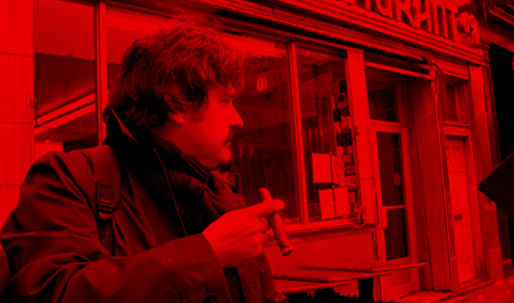
Xefirotarch has been selected the winner of this year's MoMA/PS1 Young Architects Program and will be building the pavilion for the 2005 WarmUp. Archinect editors Francisco David Boira and Zoë Coombes met with principal, Hernan Diaz Alonso for breakfast early on a rainy Saturday morning. Francisco David and Zoë both ordered the granola. Hernan ordered steak and eggs.
FDB: Congratulations on winning the MoMA/PS1 Young Architects competition! Were you surprised?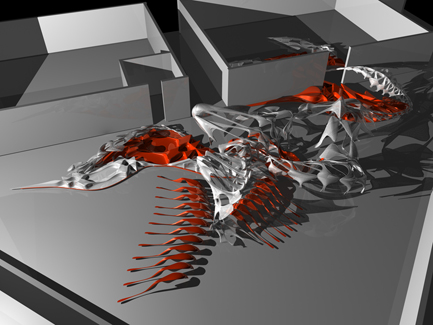
Above: MoMA/PS1 winning entry, 2005.
HDA: [Laughs.] Ha. Yeah, you are always surprised when you win. It's kind of weird to feel you've gotten away with it. So, when we got into the top five, that kind of surprised me because our portfolio was full of these kind of, well... extreme projects.
FDB: But you won...
It wasn't like they call you and just say "You Won." It was more like, "We picked you, but we want you to produce a prototype and when we see the prototype, we will go ahead. They had a lot of questions about the viability of the project.
FDB: Your practice hasn't built much in the past...
HDA: Well, that always has been in one way or another, the intention of the program at PS1. They've always been supportive of people who don't have an extensive 'construction trajectory' lets say. Nevertheless, I have built in the past. Not a lot, but I built in Argentina.
FDB: What did you build?
HDA: A series of stores and a public school. But this was before the computer era. I think they really liked the portfolio. Perhaps part of our mystery was that in the States, the only thing we've built was the installation in Los Angeles.
Above: Emotional Rescue at SCI-Arc, 2002.
ZC: Are you referring to 'Emotional Rescue'?
HDA: Yeah. But we also have another project going on now in L.A which will be built. The client is spectrum3D - the company that normally does our prototyping. They are a peculiar client because they are also fabricating the parts.
FDB: But back to PS1, what is your proposal about?
HDA: The project, like all projects in the office, belongs to a family. This project belongs to a family which began with the competition entry for the Pusan Concert Hall. For Pusan, the design we submitted earned us fourth prize.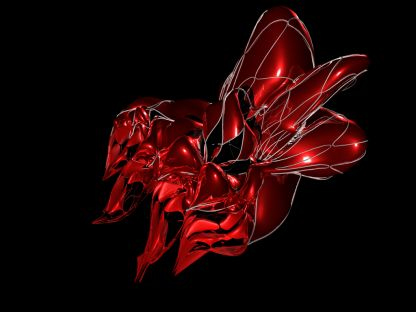
Above: Pusan Concert Hall, Korea 2004.
When Archilab and the Venice Biennale asked us to send the Pusan entry to be included in the show, we took the opportunity to develop it further. In the end, we created whole new families of ideas in relation to topology and cellular aggregations and started to work more and more with scripts and particles. The development of that project and the model and some of the renderings and the plans and all the things you have to do for something like the Venice Biennale, were used as a laboratory for where we wanted to go next.
FDB: And this was what the design for PS1 is based on?
HDA: Yes. What we did for PS1 belongs to the family that began with the concert hall. It became more precise and the scale is smaller. But, like Pusan, it operates with a logic that starts with a singular cell that multiplies based on a code. The coding of the cells begin to behave much more like organisms that relate to each other so you create a whole where the parts are not modular. Rather, it is an incremental variation of a singular unit. The other part of the project was the context, in terms of it being a project in a place like New York in the summer, and all those other things.
ZC: Which other things?
HDA: Well, the project had this kind of cross condition between cartoons, and amateur pornography. It tried to restore the notion of play, and ways of creating multiple scales to be discovered and occupied in multiple ways. There is a very conscious development of the problem of the cartoon which is a steady by-product of techniques that explore the grotesque and the horrific, with a kind of childish, playful attitude.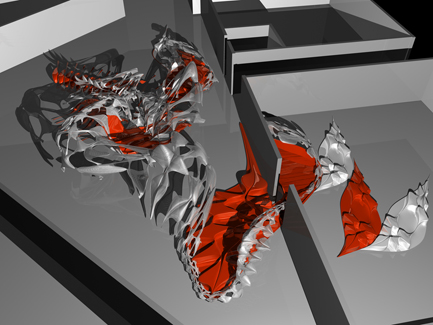
ZC: Are we supposed to feel the design is beautiful?
HDA: I don't know. I used to think that the work we did was about a search for a new definition of beauty. I don't think it is about that any more. I think it is the whole exploration of the problem of 'affect' and I think that affect has to do certainly with an aesthetic condition. Someone could argue that the grotesque is in some sense, a condition of beauty, but for me, the project has much more to do with this moment where the grotesque and the horrific, things that are a little bit unknown, become codified and known. Throughout time every artistic expression couldn't at first be classified in the traditional cannon of aesthetics. No, I don't think this project is beautiful in the traditional sense of beauty. I think it is much more related to the problem of the sublime. It is a different problem, and I think it is what Kipnis is trying to define in this transformation between the work of Bacon and the Koons.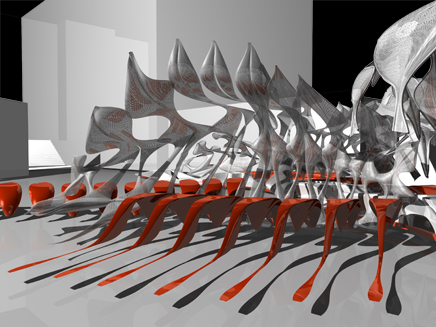
ZC: Speaking of Kipnis, he always says your work has a lot of Tango in it. You are the first Latino architect to win PS1...
HDA: Well, maybe if we trace the blood heritage of some of the other winners there is more Latino blood... But, no, seriously, I've had this conversation with Jeff about the Tango and the 'syncopa' which is a kind of theoretical argument that has the attention of the painter Fabian Marcaccio which has to do with tango and the relationship to his paintings. Kipnis argued that my work has that kind of dynamic movement- that it is topology mixed with tango. I think that in this case, it is fine to say that because the work has a kind of melancholic romantic condition which I think my work always has.
ZC: Does it build upon tradition?
HDA: In the end, what ever you do always belongs to certain traditions. What I like about the project is that I think it is a good syntax of many visual things that interest me, and influences of people who have been important in my career. A lot of childish, playful attitude has come from Enric Miralles and then you have a lot of rules of order and organization which have much more to do with Eisenman .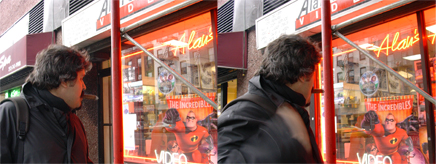
Of course, I have all this technique and digital dreaming work that has been a big influence from Greg Lynn, not only for me but on my whole generation. And there is the whole problem of 'affect' which has been the main subject of my exploration which has come from Jeff Kipnis who has been a big influence in my life. And I think the horrific and the grotesque have come from conversations with Eric Owen Moss. But as I was saying, I think you are who you are, and your work starts to relate to your evolution. I never make a serious scientific argument even though I use techniques and methodologies that are very precise and very mathematical and algorithmic. I think my work is much more corrupt in the whole notion of the process.
FDB: Your drawings remind me a lot of Miralles drawings, although he never relied on computers.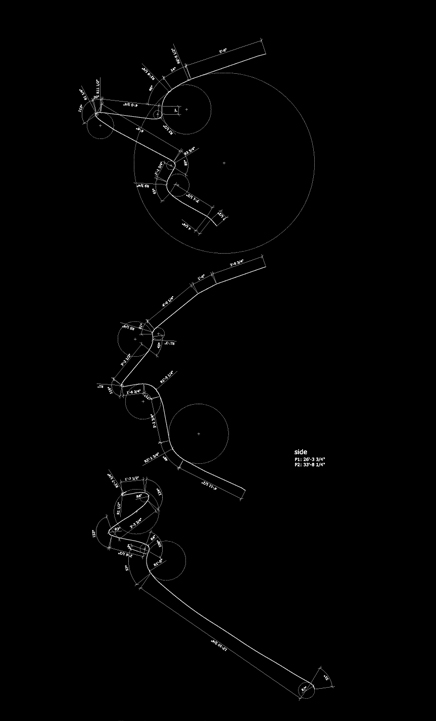
HDA: Yeah.
FDB: But do you rely on your drawings as a way to indicate how the project should be built? How does his drawing technique influence your work?
HDA: Of course there is a lot of influence from Enric because he had an ability to think about the project without distinction from representational to construction drawings. In addition, people like Peter never made a distinction between design and construction drawings because they are part of the same process.
FDB: How about new techniques?
HDA: One of the things that fascinates me the most about new techniques is the opportunity to compress and collapse time which allows things to happen through coding. It has the potential to be embedded with all forms of information. Now, there have been changes in that as well. When I look at my work from 10 years ago, prior to computers, we used to do everything in plan, models and so on, which produced the three dimensionality as a byproduct of the geometry of the plans. Section never interested me in the past. It still doesn't interest that much actually. In this sense, there's been a 180 degree change over the drawings, because the drawings have become a byproduct of the manipulation of the form.
FDB: And the notion of drawing?
HDA: I think that now the logic of topology and form come first and the drawings are the byproducts. These in turn then start to set up the rules, but they come after. There is a whole series of transformations about what plans and sections mean today, which is just part of a much larger operation.
FDB: Your office is already trying to understand how the canopies will be built and transformed from three dimensional model into a two dimensional working drawing. Is there a specific technique to draw this construction data?
HDA: Basically what we are doing is asking a very simple question, which is: 'How do you transform our 3D geometry into something that can be understood as a 2D element and can then be bent and so on?' So what we are doing is projecting and coding very conventional techniques of digital projection. This is what we do to each expression, which gets printed and allows us to be able to bend the structure. What I hope for is that all this structure will have three dimensional properties that emerge from the three dimensionality. The translation has nothing to do with the possibility of fabricating three dimensions, but it has to do more with understanding the three dimensional geometry to produce, in this case, the structure of the canopies.
FDB: Word.
HDA: At the same time, I don't want this to sound complicated and so sophisticated because it's just a pavilion! It's not the Guggenheim, Bilbao. I mean I don't want to treat this project like it is a big money fest or anything. We are just trying to have fun and enjoy the ride and be absolutely irresponsible and childish and see what we get. And I think we will succeed in certain aspects and fail miserably in others. If not we'll open a restaurant somewhere.
FDB: Really?
HDA: No. However, projects do come from the frustration stemming from not being able to become a film director. Instead, I try to be cinematic with my architecture. All the projects explore dynamics and animation in order to develop a project almost like a small film which can be split and recombined. The process is much more corrupt, just as a film is made, so it is never a linear process. It's always edited at the end for multiple sequences.
FDB: Do you make a conscious decision to place your renderings and ideas on a black background? 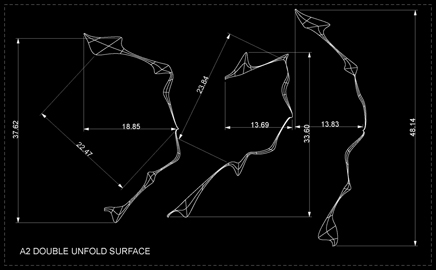
Canopy unfold surface sample.
HDA: Yes. There is always this kind of science fiction, a sense of unreal. It's a very conscious decision, even though everybody operates within these domains, there seems to be a move towards white backgrounds, but we are going to keep resisting and keep rendering with black backgrounds.
FDB: Does the black background and red accents have anything to do with your period at Columbia?
HDA: At the beginning it was a little bit by default, and then you keep evolving until you kind of start to develop your own in a particular way, so for me it has to do with this extreme parallel reality aspect that I am interested in developing with the work.
FDB: You don't like the color blue. Nevertheless you have a new Alienware laptop which happens to be blue.
HDA: Oh man. I'd rather not talk about that. They didn't have a black one, so when I wanted to return this blue one (which I didn't request,) they said it would take more than a month to send me one in black, so I opted to keep the blue because we needed the machine. So that's that.
FDB: But again, what's the issue with the blue color?
HDA: It is like a neutral thing! It has no commitment or passion to it. When you don't know what to do, you get blue.
ZC: I heard a good audio clip from architectural record from an interview that you gave a couple of years ago.
HDA: Oh, that's very old!
ZC: And in it, the interviewer asked you where you thought you would be in five years. One of the things you said was that you hoped that you wouldn't have to negotiate your deep philosophical convictions about what architecture should be. Have you?
HDA: No. No! I think in that category, we are doing well... Yes, in that category we are doing well. I think so far, so good. America is good because it allows you to teach.
ZC: America? America opposed to where?
HDA: Opposed to Europe or Latin America. Academia here supports your research, your investigations, and your work with students but also, it gives you a lot of freedom because it pays you well so you don't have to comprise your work. In the end you have to compromise, but I think the issue is where you choose to compromise. The compromise I do is in moving from the digital to the real world. In that, there is a reduction that needs to happen, but that compromise should occur under your own rules. On that part, I have to say I am still pretty happy and proud of the practice we've developed. Anyways, we haven't had that many clients who have tried to corrupt us, so I don't know how solid my ethics are. Nobody has offered me a 60 million dollar project, so the truth is: I've never been tested deeply as to how strong my moral values are.
FDB: You also said in that interview that you hoped to be involved with new technologies of manufacturing while finding new possibilities of producing singular work. Does the PS1 project seem like the right challenge for this stage of your career?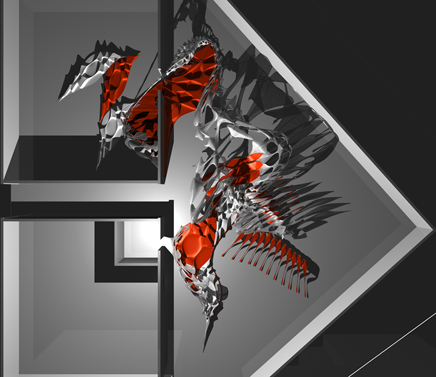
HDA: It is, but due to the time frame, it forces you to improvise. Let me put is this way. I always hate when architects defend their base in the limitation of the budget. Everyone knows the rules of the PS1: its tight a schedule and a limited budget and I don't want to argue over those terms. All the way along, we are trying to apply as much innovation as we can. Nevertheless, we are going to be using a lot of conventional techniques. I always like that part of the problem where there is a negotiation between 19th century technology and 21st century technology. I think we are still trapped in that, because I don't believe the discipline has made a total transition. This project is not going to be either 100% new technologies, nor 100% traditional ones so there is going to be some kind of a bridge.
FDB: Is this a digital project?
HDA: Yeah sure absolutely!
FDB: Is it digitally produced?
HDA: It will have some digital production, but it will involve a lot of analog production too. It is a digital project in the way it was conceived, in the way that it was thought about from the conceptual point of view, and in the way we thought about the problem of geometry and form. It is also digital in terms of form in relation to topology. Here I think digital technology or digital techniques give you much more precision. They allow you to be more precise in the relation to that concept. We are seeing a generational shift in that sense. I think people of older generation see digital technology as what it can do for me?
People of my generation think more like "Ok what can I do for you?" The transfer of power is slightly different.
ZC: You really work in two different cities, teaching in LA at SCI-Arc all year, and in New York at Columbia in the spring. Maybe you are a little unusual because you really are in studio for all the scheduled days.
HDA: Yeah, I am still not in the Diva category where I am a total star and don't show up for studio.
ZC: Is it tiring or energizing?
HDA: No, it's energizing in every aspect. But you do start to wonder when you look at your flight as your moment to rest and you realize there is something wrong with your life. On the other hand, I don't want to be a cliché like everyone who complains about so much traveling. I like it. Let me put it this way: SCI-Arc and LA are my wife and NYC and Columbia University is my mistress. SCI-Arc has been my house and is the place that offered me all the chances, the people that understood and so on. Columbia is the place I enjoy visiting and being a visiting professor. My role here in New York is more peripheral. The laboratory where I developed all this stuff is in LA., at SCI-Arc. Actually my wife seems to be very happy that I get out of the house so she doesn't need to suffer me everyday of the week. It seems like it's working for everybody.
FDB: We heard that students really appreciate your studios because you also know how to use and operate the same tools that they use everyday in studio. Do you learn a lot from your students?
HDA: Oh yes. I mean, that is the whole point of teaching. My studios and seminars are always centered around exploring something that I don't know. I never base the studios on things that I have done in the past. For me, teaching has become the first line in the laboratory where we explore the ideas of where we are going. PS1 has been enormously influenced by the work we have been doing with students throughout the years. The whole notion of scripting, coding and particles is the by-product of all the explorations we have done in studios. Again, it sounds like a cliché, but I think that what makes America so unique is the possibility of the Academy. It is the kind of conditions that you find at SCI-Arc that become a true laboratory where you can research. And also, I try to revendicate this notion of fun. Architecture should be fun. I like to have fun with the students and like the students to have fun with me. To play like children who play very seriously, is the concept that I always try to follow. My studios are very brutal in terms of the rhythm, but at the same time, we have to try to not be dramatic or stressed. Architecture is important but we are not curing cancer. It's just a kind of a game.
ZC: Do you ever check Archinect?
HDA: No. I used to love it when it was this kind pirate, clandestine, bitching territory. To tell you the truth, I liked it because it was anonymous and everyone was trashing each other. I got trashed a couple of times on Archinect. I got supporters too.
ZC: Do you have a screen name?
HDA: No, I don't have a screen name. I don't log in anymore. I still check the news but I don't look at the discussions. I think it is a thing you do at a certain moment in your life and then you have to let it go. When your work starts to become more known, and you start to get discussed, (and I say this without arrogance!) the best thing to do is to not pay attention to what the people think of you, and focus on what you need to do. So I try not to look that much at what people say about my work. Some people like it. A lot of people hate it, and that's fine. Basically, I used to enjoy Archinect more when it was all about gossiping and now it has become more serious. Everybody is growing up, I guess...
FDB: Hernan, thank you very much and once again, congratulations.
HDA: Thank you.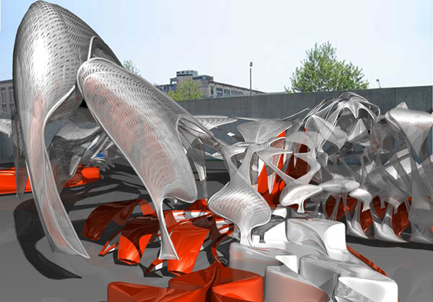
Credits:
Xefirotarch - Hernan Diaz Alonso
Principal in charge
Hernan Diaz Alonso
Project Architect
Bryan Flaig
Project Designer
Mark Nagis
Design Team
Ben Toam
Hunter Knight
Chris Antzen
Evan Tribus
Casey Rhem
Francisco David Boira
Alex Pincus
Zoë Coombes
Associate Architect
Alexis Rochas
Executive Architect
Rives Rash
Engineer
Bruce Danzinger
Arup LA
Consultant
Neil McClelland
Arup New York
Fiberglass Fabrication + molding
Drura Parrish
Spectrum 3d
Advance Architecture group
25 Comments
I'll have to admit, Hernan is a great teacher. Excellent interview (surprisingly lengthy) and quite a good summary of last semester's lectures and personal convictions. Three cheers for Ben (not Bean) Toam... hehe... a fellow studio mate. I can't wait to visit PS1 during the summer break and SFMOMA's show/monograph about Hernan. Yo Joe!
As I commented previously, P.S.1 blew it this year. Hernan is the architectural version of the eight track tape. Endlessly repeating, he will eventually be collecting dust in a corner. This was a truly unfortunate choice.
So far the score stands:
Maya Goons: 1
Architecture: 0
hey hernan, congrats on this achievement, bhushan mantri aadrl london
Great interview FDB/ZC.
Although not a fan of his forms, this interviews opens a window into his mind. Forms aside I respect him for not only for this achievement (PS1), but for his constant exploration/experimentation...the question is when does it become too repetitive/loses it's wow factor?
"Architecture is important but we are not curing cancer. It’s just a kind of a game"
hum.
Have I bitched about Hernan Diaz "Cigarface" Alonso before to you? Maybe, every time his stogie-donned visage pops up like some bizarre cross between Columbo and a tyrannical Latin-American dictator, my blood pressure rapidly increases and I have to curse. Incase you have missed my rant: Hernan is one of the most arrogant, lost, boring, hackneyed, trite mofos and I cant believe they awarded him this potentially significant design opportunity. I was convinced of his fallaciousness when he “won†the competition for an urban plaza in my hometown of Lexington, Kentucky; his design there was just as irrelevant as it is here…funny how it has evaporated from his labyrinthine website (ahh! his face again!). He is actually going to build that fragmented, magenta, alienvspredator tent in the courtyard there? Let’s hope the materials can be easily recyled.
I hope people don't confused this with architecture
That interview is going to open a can of worms now. All haters take a number and stand in line.
my 2 cents? not a big fan of his forms but would love to see it built, it may become somting really incredible when built.
I'm dissapointed, where are the worms?
or are you guys growing up too?
my take: the images looks horrific to me. I am afraid of those forms. but then again I don't feel that comfortable around Gehry's buidings either.That's not very important, though.
But this confusion between beauty versus sublime(that only recently clarified) signals that the theory was never very well developed which is kind of surprising to me: I expected him to be much more articulate about the underpinnings of the work.
ok, people that do blobs look like blobs.
i'm a bit overweight. should i start eating more and learning rhino?
or diet and forget about it?
looks over taste! style over substance!
I agree with the premise 'looks over taste,' but 'style over substance' sounds like an ad campaign for Paris Hilton.
Post-postmodern hedonism.
Or it was Supermodernism?
Going from digital to the real is a compromise?
Architecture was not supposed to be that thing that produced real, progressive transformations on the physical world to allocate necessities, desires and aspirations of society?
I’m not going to be one of the guys bending copper tubes with their own hands.
enric miralles would roll over if his drawings were compared to a computer nerve ending.
this is the most interesting part of the interview:
I always like that part of the problem where there is a negotiation between 19th century technology and 21st century technology. I think we are still trapped in that, because I don’t believe the discipline has made a total transition. This project is not going to be either 100% new technologies, nor 100% traditional ones so there is going to be some kind of a bridge.
would be nice for him to elaborate on how that figures in this project. i will be watching to see the percentage of 19thC and 21stC in the outcome.
Hernan is an insecure man who has to lie about how many projects and huge clients and exhibitions he has (i have a solo show at SF MOMA, I have an installation in Costa Rica, I have a project for Motorola, blah blah blah) to make his small ego feel better. This project may be nice.. but the bigger problem is that Hernan represents all that tends to be wrong with young architects today. All they want is to be famous and regarded, so the chew up people to get there, have no respect for spirit or people, and lie and lie and lie to make themselves feel more important in front of students who arent that far behind their career decelopment (or extreme lack of).
As a side rant.. id be interested to know what 21st century technologies hernan will be using in this project...
is it computers? (20th centurs), maya software (20th century) fiberglass (20th century) slave labour (14th century) bent copper piping (2nd century) stretched polymer fabrics (20th century)... where is the cutting edge 21st century that he uses? Is is possible the great Hernan really has no idea what comesout of his mouth?
Ok...just to point out, directly from his own wordings.
"This project belongs to a family which began with the competition entry for the Pusan Concert Hall. For Pusan, the design we submitted earned us fourth prize."
Liar. (with the references to the truths including)
1) There was no competition for the Pusan Concert Hall. He made some bloby things for a competition to the city of Busan. It was a competition that he had done in collaboration with Peter Zelner and Marcelo Spina. (www.xefirotarch.com)
2) They did not "earn" 4th prize. If you count being one of 10 honorable mentions "4th prize". (http://biarc.org/2003/)
Can somebody please let this fella know that he cant lie anymore.
Worms are out, here are my two cents:
I respect his work for the constant push in new direction, I don’t completely agree whit
Hernan’s approach to architecture, but I respect his passion, the interview appears to me as very honest and straight forward. It doesn’t reveal clearly the methodology and the ambitions behind the work, which it seems to be part of his way of taking about his work, I saw him lecturing at MIT last year, and he did the same. So either it doesn’t want to talk about it or it doesn’t have much more behind.
On a different note, it sad to read how the comments are becoming personal attacks, instead of discussing the wok or the ideas, even if you completely disagree with, then, which I do with many of then.
Particularly hotsie, seems that you have a personal history with hernan, and I have one too, I know him pretty well, but if you want to trash somebody, you have to do two things, first sing your name, is not a coward act, second get your facts right.
He has a solo show at SF MOMA, opening at the beginning of next year, is part of the design series, this is confirm by Joe Rosa, the architecture curator, who happens to be my teacher, second the Pusan Concert hall, was part of the Bay master plan competition, and yes it was a honorable mention and not a fourth prize, the concert hall part was later continue for the Venice Biennale, Peter Zellner was consulting with the programming and Marcelo Spina wasn’t part of it at all, the installation in Costa Rica, was at the end canceled, because lack of money, and he was part, with another 20 people of different disciplines, of IF THEN MOTO, a think tank that Motorola put together a couple of years ago.
It seems to me that you are motivated by a personal vendetta, but you don’t bother to discuss the work, which by the way you seem to think is nice.
Well, well, well, boohoo. Unfortunately (or fortunately for those of us who wallow in the more cynical side of this wicked profession) there is nothing manifest in his work to critique other than his personality. His work seems to be the disproportioned backwash of the previous laminated personalities; Miralles, Eisenman, Kipnis, etc. The notion of a “young architects†appropriation automatically conjures up youth, enterprise, discovery, unfortunately, again, Hernan can’t seem to do better what his mentors already did. That sucks. What is even suckier is that he embodies everything that is wrong with “experimentation†in architecture today. Forget an LEED certification, it would be nice to see some work that was grounded, or even some ethical gravity. Play is wonderful in architecture, but really play, then! His generated three-dimensional forms and washed-out colors have less allure than abstract expressionism in the 1950s--even in its most frivolous, encrusted state, Baroque architecture had a heart in the perfected resonance of geometry. (take S. Ivo as an example) His “style†wouldn’t bother me if it were crafted with the principles that allow it not to mock our own humanity, and if it actually took us somewhere new.
Mock our humanity? Backwash? I suppose you're horribly original then yourself, right? Anyways...
As a student of his, you won’t feel more tended to and cared about – in a true sense, he becomes your paternal architecture guide for the semester, and truly (this is the difference) he *does* intensely care. Albeit that he's not always the most moral of people where using student slave labor is concerned (...i'm sorry, are we talking about the same profession? is this new to you guys?), just look around your studio right now and tell me that you're "surprised" that architecture breeds pretention. The point is, he's an intense and very influential professor - which is all you could want out of it, right?
But if you’d like to be mature and stick to the issue of his work, however, I wouldn’t imagine that anyone being chosen for the new young architect’s award spotlight would be considered part of the “norm†of today, but rather the opposite. It’s supposed to provoke – wtf did you think this was all for, anyhow? Rehashing? No thanks. He’s pushing something, and whether or not you like it or if you go home having wet dreams about it doesn’t really matter – he does it to the extreme, he does it with intense passion, and if you're smart enough you’d figure out that that is one of the truest validities in any architect’s work. Affected or not, appreciate it for what it is, play with it, and move on - and stop being so bitchy.
this guy is the chihuly of architecture.
"I always hate when architects defend their base in the limitation of the budget."
He can hate that all he wants, but its a valid factor in any end product. Ask him why his installation doesnt look better, or closer to the renders on his website...is it becasue its what he wanted? I doubt it.
Lets see what happens with his PS1 project. My money is on him using the "budget card" when it looks thin and incomplete.
I'm trying to make sense of "process" in architecture. I agree with some things in this interview (and comments) and disagree with others. Does generating form using scripts and other random digital processes mean that architects:
a) can now justify form through "process" (and do we need to?)
b) can divest themselves of/reject yet another responsibility
c) "help us discover new possibilities" (perhaps*)
d) whatever (my personal favourite)
*Most of us aren't fond of cliches. Believe what you want!
I have to say if it is generating something, that would be discussion, and that in itself might be a good thing.
I personally think that if you design without accounting for viability/feasability, you are working within the realms of pure design and not architecture.
XEFIROTARCH, Who are they?
ahhh, hernan. he's really just a big goof. he just wants to be ridiculous and find a personal space in architecture. actually his comparison of his and miralles work is pretty apt. if you were to render his forms in concrete, they would very much begin to remind one of miralles. he, in that sense, is still very close to his mentor. for the scottish parliament project, miralles came to the interview with a pile of leaves, hernan comes with a pile of plastic leaves....
i'm not the biggest fan of his form-making nor do i believe that it will be an incredibly nice space...but i do respect his intensity in defining a light-hearted personal take in an incredibly rigid, sombre, overly serious profession.
"Hernan is one of the most arrogant, lost, boring, hackneyed, trite mofos"?
In my my first final review,(undergrad), Hernan was one of the critiques.
I was up there a long time, and Hernan was talking a long time too.
We have never even met, and to a bystander he may have looked like a evil bully.
But to me? Almost all of the questions he raised was very valid. He sure does look and sound arrogant and mean, but despite that, I felt that his comments were tremendously helpful and, actually very respectful.
I have seen him in the later reviews, and unfortunately I didnt get to be a part of it, but his comments were tremendously sharp and to the point.
My experience, although it was couple hours of him critiquing my project, is that he is very sharp and respectful, personality wise.
Block this user
Are you sure you want to block this user and hide all related comments throughout the site?
Archinect
This is your first comment on Archinect. Your comment will be visible once approved.